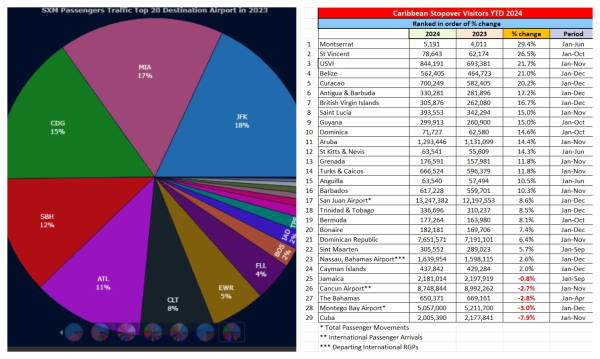 Dear Editor,
Dear Editor,
The recent article published by The People's Tribune, titled “St. Maarten’s Diminishing Regional Hub Role, Minister’s Presence at Routes Has Added Significance,” highlights an urgent challenge facing St. Maarten’s aviation sector. For decades, Princess Juliana International Airport (SXM) served as the primary hub connecting nearby islands like Anguilla, Nevis, Tortola, and Dominica to the rest of the world. However, this position has steadily eroded as these islands develop their own direct air connections with major U.S. carriers, reducing their reliance on St. Maarten as a transit point.
A reader recently shared a compelling commentary with me on this issue, arguing that the decline of SXM’s hub status was inevitable. The lengthy reconstruction period after Hurricane Irma, combined with advancements in aircraft technology, has allowed airlines to bypass St. Maarten entirely. Smaller airports that once depended on SXM as a gateway now receive direct flights, eliminating the need for travellers to connect through St. Maarten. The reader further pointed out that the transfer process at SXM is cumbersome, making it an unattractive hub compared to direct flights that offer travellers greater convenience. If St. Maarten is to maintain its role in regional aviation, it must reassess what value it truly offers to transit passengers and whether the traditional hub model is still relevant.
The most pressing challenge is that airlines operate on efficiency and profitability. American Airlines, JetBlue, and other major carriers now serve Anguilla, Dominica, and Tortola directly, giving travellers a simpler alternative. Meanwhile, Anguilla and Nevis are expanding their runways to accommodate larger aircraft, further diminishing their reliance on St. Maarten. At the same time, SXM has struggled to modernize its transit passenger experience. Lengthy immigration processes, baggage re-check requirements, and a lack of seamless transfer options create unnecessary friction. The reader questioned what SXM truly offers as a transit point. Layovers here provide limited shopping, dining, or leisure options, making it an unappealing choice for travellers compared to direct flights. Additionally, St. Maarten’s road infrastructure presents another obstacle. Even if transit passengers extend their stay for a short visit, they face frustrating congestion. A trip from Maho to Philipsburg or Grand Case can take more than an hour in traffic, limiting a visitor’s ability to experience the island in a meaningful way.
Instead of focusing solely on reviving SXM’s hub status, St. Maarten should reposition itself as a high-value destination that travellers choose for its unique experiences. The traditional hub model is no longer a reliable economic driver, and other islands are proving that direct connections are the future. St. Maarten’s approach to aviation and tourism must be redefined. Rather than concentrating on bringing in more transit passengers, efforts should be directed toward improving infrastructure, easing traffic congestion, and enhancing the overall visitor experience. The island’s natural beauty is an asset, but without a well-developed tourism product, visitors may find it lacking in comparison to other destinations. There needs to be a greater focus on establishing attractions that set St. Maarten apart from other Caribbean islands. Casinos and bars alone are not enough when tourists can find these options elsewhere, including in their home countries. If the island is to maintain its appeal, it must offer a richer and more immersive experience, making it an attractive place to stay rather than just a stopover.
The upcoming Routes Americas 2025 forum presents a crucial opportunity for St. Maarten to reposition itself in the regional aviation landscape. However, if the primary focus is to pitch SXM as a transit hub, the island will likely struggle to reverse its declining relevance. The Minister of Tourism, Economic Affairs, Transport and Telecommunication, Grisha Heyliger-Marten, must take a broader approach by securing direct flights from key U.S. cities to offset the losses in regional transit traffic. Strengthening airline partnerships and expanding connectivity beyond the United States, particularly into European and Latin American markets, will also be critical. Furthermore, improving the transit passenger experience through streamlined processes and better facilities will be essential in retaining SXM’s competitiveness.
St. Maarten cannot afford to rely on an outdated strategy. The hub model that once worked is no longer sustainable without significant operational improvements and a strategic shift in focus. Competing islands are evolving, and if St. Maarten fails to adapt, it will be left behind. The future of SXM does not depend on clinging to its past as a hub but rather on transforming itself into a destination that travellers actively want to visit and experience. The time for rebuilding is now, and that means more than just an airport—it means a new vision for St. Maarten’s role in Caribbean tourism.
Terrance Rey












